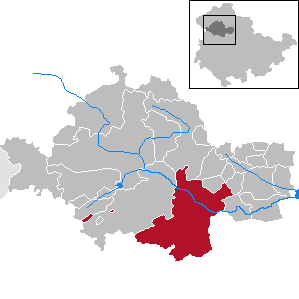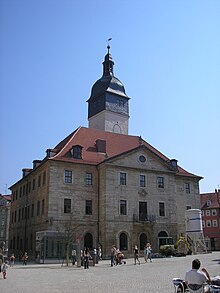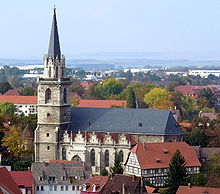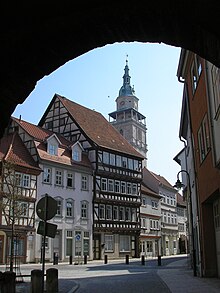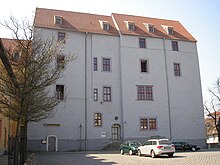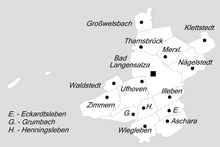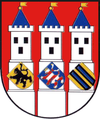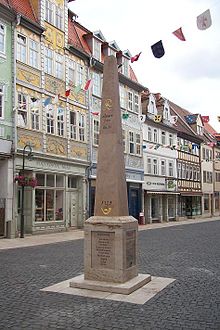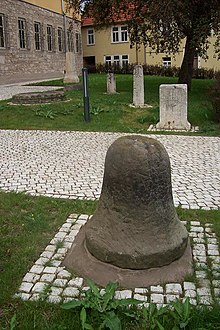Bad Langensalza
| coat of arms | Germany map | |
|---|---|---|
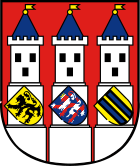
|
Coordinates: 51 ° 6 ′ N , 10 ° 39 ′ E |
|
| Basic data | ||
| State : | Thuringia | |
| County : | Unstrut-Hainich district | |
| Height : | 200 m above sea level NHN | |
| Area : | 129.37 km 2 | |
| Residents: | 17,271 (Dec. 31, 2019) | |
| Population density : | 134 inhabitants per km 2 | |
| Postal code : | 99947 | |
| Primaries : | 03603 036041 (Klettstedt) 036042 (Nägelstedt) |
|
| License plate : | UH, LSZ, MHL | |
| Community key : | 16 0 64 003 | |
| LOCODE : | DE BLZ | |
| City structure: | Core city; 13 districts | |
City administration address : |
Marktstrasse 1 99947 Bad Langensalza |
|
| Website : | ||
| Mayor : | Matthias Reinz ( independent ) | |
| Location of the city of Bad Langensalza in the Unstrut-Hainich district | ||
Bad Langensalza is a spa town in the Unstrut-Hainich district in Thuringia . It is the second largest city in the district after the district town of Mühlhausen and forms the middle center for its southeastern part and for some communities in the northern district of Gotha .
Bad Langensalza is one of the historically most important cities in the Thuringian Basin , as evidenced by the rich historical buildings in the old town. With a walled area of over 50 hectares, it is the third largest old town in Thuringia after those of the neighboring cities of Erfurt and Mühlhausen. As one of the woad towns Bad Langensalza was very wealthy, so that large churches and a mighty city wall made of Langensalza travertine , which could be mined directly in the southwest of the old town, were built. A large part of the old town has been restored since 1990.
Later healing springs were developed in the city, which are still used by the spa today. This was accompanied by the creation of several parks, such as the rose garden and the Japanese garden.
geography
Geographical location
Bad Langensalza is located in the Thuringian Basin , the fertile lowlands along the Unstrut . The Salza flows through the city itself and flows into the Unstrut about two kilometers east of the city. Bad Langensalza is located in an unwooded, intensively agriculturally used, flat, undulating landscape that rises to the west to the Hainich , north to the Heilinger heights and to the southeast to the Fahner heights . Due to this location, the climate in Bad Langensalza is relatively mild and very dry with annual rainfall of around 500 millimeters.
The city itself is divided into the relatively large old town, the boundary of which is the historic city wall, as well as several urban expansion areas from the period from 1850. Initially, the city expanded towards the train station to the south and south-east. The first industrial areas also emerged here. This was followed by an expansion to the southwest, where the village of Ufhoven , incorporated in 1950, is located, which has now fully grown together with the core city. Since 1950, the city has expanded mainly to the north, where several residential and commercial areas were created. The municipal reforms since the beginning of the 1990s have greatly enlarged the administrative city area and now extends from the forests of the Hainich National Park to the eastern side of the Unstrut.
Neighboring cities
Neighboring cities of Bad Langensalza are Mühlhausen , 20 kilometers northwest, Eisenach , 30 kilometers southwest, Gotha , 20 kilometers south, Erfurt , 30 kilometers southeast, Sömmerda , 35 kilometers east and Sondershausen , 35 kilometers northeast. Neighboring communities are (clockwise, starting in the west): Schönstedt , Unstrut-Hainich , Nottertal-Heilinger Höhen , Kirchheilingen , Sundhausen , Tottleben , Urleben and Großvargula in the Unstrut-Hainich district, Tonna and Nessetal in the Gotha district and Hörselberg-Hainich in Wartburg district .
City structure
Bad Langensalza is divided into a total of 14 districts:
| District | Residents |
|---|---|
| Core city and Ufhoven | 13,690 |
| Ashara | 491 |
| Eckardtsleben | 246 |
| Großwelsbach | 315 |
| Grumbach | 286 |
| Henningsleben | 257 |
| Illeben | 274 |
| Klettstedt | 218 |
| Merxleben | 481 |
| Nägelstedt | 730 |
| Thamsbrück | 1,041 |
| Waldstedt | 108 |
| Wiegleben | 390 |
| Rooms | 351 |
On the basis of a citizens' initiative launched in 2018, the city council decided on February 21, 2019 to give Ufhoven district status. This resolution will come into force with the announcement of the amended main statutes. According to a preliminary calculation, Ufhoven has 1615 inhabitants. This means that Ufhoven is not only the youngest, but also the largest of all districts (excluding the city center).
history
First mentioned until 1815
At the beginning of the 9th century a place called Salza - in the Latin text Salzaha - was first mentioned in a document in the Breviarium Sancti Lulli , the property register of the Hersfeld Monastery at the time of Archbishop Lullus of Mainz († 786). The monastery had two Hufen and two yards in the village.
On June 1, 932, the village of Salzaha (Langensalza) was mentioned for the first time in a document about an exchange of goods in the Westergau between the German King Heinrich I and the then abbot of the Hersfeld monastery, Megingoz.
In 1070 Ludwig the Springer from the Ludowinger family donated the Church of Our Lady in Salza. Three years later an assembly of princes was held in the Reichshof Homburg an der Unstrut . As part of Henry IV's Saxon War, the battle of Homburg and Nägelstedt on the Unstrut took place on June 9, 1075 . The royal army triumphed over the united rebellious Saxon-Thuringian army. The Halberstadt Bishop Burchard II , one of the leaders of the rebels, was arrested in the Homburg.
In 1136 the foundation of the Homburg Benedictine monastery was renewed. Emperor Lothar III. determined the conversion of the nunnery into a monastery. The monastery belonged to the Archdiocese of Mainz and was placed under the protection of Pope Honorius .
In 1196 awarded Bernhard III. of Saxony (?) and Heinrich V , Count Palatine near the Rhine , the Homburg monastery, St. Stephen's Church in Salza, including patronage and property.
In the Staufer-Welf throne dispute , the Dryburg in Salza was besieged by Emperor Otto IV in 1212. After a brief resistance, the besieged gave up. In the same year, the emperor is said to have granted the village town charter. The first reliable mention of Salza as a city (" oppidum ") is documented in a document by Werner von Eppstein . The Archbishop of Mainz extended an interdict imposed on the city and forbade the residents to trade in Erfurt.
The first evidence of a Langensalza (Salza) mint was provided with bracteates belonging to the Lords of Salza, minted from around 1255 to 1300.
The city wall with four entrance gates was completed around 1300. Today four city wall towers are still preserved from the oldest city fortifications.
In 1325 Günther IV. Von Salza and his sons founded the White Women's Monastery .
Because of a dispute between the Landgrave of Thuringia, Friedrich II. , And the Archbishop of Mainz Heinrich von Virneburg ( Thuringian Count War ), the city was besieged and destroyed in 1346. In 1356 Jacobstadt, Neustadt and Altstadt merged and formed a joint council. A city wall with seven gates and more than thirty watchtowers was built.
After the Saxon division of inheritance in 1485, the town and office of Salza belonged to the Albertine Duchy of Saxony .
On April 25, 1525, a revolt of the craftsmen and farmers began in the course of the peasant war . The insurgents forced twelve seats on the city council. In 1578 the city was first mentioned as "Langensalza". The people of Pappenheim looted and pillaged Langensalza in 1632 during the Thirty Years' War .
The city was on the Leipzig - Kassel post office route established in 1700 as part of the Moscow - Amsterdam long-distance post line .
A devastating city fire in 1711 reduced parts of the old town to rubble and ashes. The town houses that were built in their place in the splendid Baroque style still shape the image of the city today. In 1751 the Friederikenschlösschen was built for the Duchess Friederike von Sachsen-Weißenfels (1715–1775). Sulfur springs were discovered in 1811 . The first sulfur bath opened in the bathing forest the following year .
History from 1815
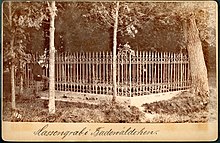
for the dead in the battle of Langensalza ; Cabinet photo number 42 by Christian Gottfried Bregazzi , handwritten dated 1891
After the Congress of Vienna , Langensalza came to Prussia in 1815 when Saxony was partitioned . During the German War on June 27, 1866, in the battle of Langensalza, Prussian troops advancing from Minden and Hamburg were defeated by the army of the Kingdom of Hanover , which nevertheless capitulated two days later to the superior Prussian army .
In June 1938, an anti-Semitic inflammatory exhibition was shown in the Reinhardbrunner Hof , which made a propaganda contribution to the persecution of Langensalza Jews. Likewise were Sinti - and Roma -families pursued, some of which in the concentration camp Langensalza , a subcamp of the Buchenwald concentration camp were detained. A total of around 1,300 foreign women and men had to do forced labor there for a Junkers project .
On March 24, 1944, an air raid took place on the city. An air mine detonated at the Treischmühle and at the “Zum Schwan” hotel on today's Wiebeckplatz, causing severe damage in the vicinity, and large parts of the city center lost roofs and windows. Starting fires caused by hundreds of stick and phosphorus bombs across the city could be extinguished. The press reported eight dead and eight missing. Probably a (shot?) Heavy British bomber had flown the attack. Today there is a parking lot on the open space popularly known as the bomb spot.
On April 5, 1945, Langensalza was occupied by American troops and handed over to the Red Army in early July . It became part of the Soviet Occupation Zone (SBZ) and, from 1949, the GDR .
In 1952 the Langensalza district was formed in the Erfurt district. When the districts of Mühlhausen and Langensalza were merged to form the Unstrut-Hainich district , Langensalza lost its status as a district town again in 1994.
Since June 28, 1956, Langensalza has had the addition of Bad . After the discovery of brine and mineral water in 1996, the Kurgesellschaft Bad Langensalza mbH Thermalsole- und Schwefelbad (1997) and the Hainich National Park (December 31, 1997) were founded, the Rehabilitation Clinic an der Salza (1998), the Kurmittelhaus (Friederiken-Therme) ) (May 21, 1999), the rose garden with rose museum (July 1999), the botanical garden on the site of the former outdoor pool (June 22, 2002) and the Japanese garden (August 16, 2003).
Since June 22nd, 2002 Bad Langensalza has been called "City of Roses". On March 21, 2005, Bad Langensalza received the certificate of recognition as a sulfur-brine spa from Thuringia's Minister of Economic Affairs, Jürgen Reinholz, during a ceremony in the culture and congress center. This means that Bad Langensalza is finally considered a state-approved health resort according to German criteria. The treetop path in Hainich was opened on August 26, 2005.
On May 25, 2009, the city received the title “ Place of Diversity ” awarded by the federal government .
Incorporations
- July 1, 1950: Ufhoven
- January 1, 1992: Eckardtsleben and Illeben
- May 6, 1993: Grumbach (near Bad Langensalza), Henningsleben , Waldstedt and Wiegleben
- March 8, 1994: Aschara , Großwelsbach , Merxleben , Nägelstedt , Thamsbrück (city) and Zimmer
- January 1, 2019: Klettstedt
Population development
|
|
|
|
¹ on October 29th
² on August 31st
³ on December 31st
politics
City council
The local elections on May 26, 2019 led to the following result with a turnout of 56.3%:
| Party / list | Share of votes | Seats |
| CDU | 24.5% | 6th |
| WE | 21.3% | 5 |
| The left | 15.7% | 4th |
| SPD | 13.7% | 3 |
| Citizen list / FDP | 12.4% | 3 |
| BLU | 8.2% | 2 |
| GREEN | 4.3% | 1 |
mayor
On April 29, 2018 Matthias Reinz ( independent ) was elected mayor of Bad Langensalza with 76.9% of the vote. He took office on July 1, 2018 in the town hall.
Town twinning
Bad Langensalza maintains active city partnerships with:
-
 Oostkamp ( West Flanders , Belgium )
Oostkamp ( West Flanders , Belgium ) -
 Bad Nauheim ( Hesse , Germany )
Bad Nauheim ( Hesse , Germany )
There are also city friendships with:
-
 Ukmergė ( Ukmergė Rajong Parish , Lithuania )
Ukmergė ( Ukmergė Rajong Parish , Lithuania ) -
 Montecarlo Department ( Misiones Province , Argentina )
Montecarlo Department ( Misiones Province , Argentina )
coat of arms
| Blazon : "In Red dreispitz thought crenellated silver round towers , each with a slanting arms occupied; in front in gold a black lion , in the middle in blue a seven times silver-red divided lion , behind in gold two blue posts . " | |
| Founding of the coat of arms: In 1356, the city seal was evidently awarded by means of a document after the suburbs of Neustadt and Jacobstadt were united with the old town. This old two-tower seal, "a wheel on one Torne and a leven on the other", followed in 1387 after the Mainz rule had renounced, whereby the archiepiscopal wheel was omitted and the city came under the sovereignty of the landgrave, which blased above still today valid coat of arms. The three inclined heraldic shields, probably related to the three city districts, show the Meissnian and Thuringian lions as well as the Landsberg stakes . The coats of arms are inclined to the right as a sign of submission. |
Culture and sights
Bad Langensalza has an old town with a rich historical structure. In addition, the spa facilities, gardens and parks are among the city's attractions.
Museums
The Bad Langensalza City Museum is located on Augustinerplatz in the historic old town, in the rooms of the former Augustinian monastery. The geological collection has numerous evidence of Pleistocene plants. These are often found in the travertine rock, which is still quarried on the outskirts. The fights and events of 1866 form a focus of the local and urban history exhibition.
In Haus Rosenthal, one of the oldest buildings in town, the Bad Langensalza Pharmacy Museum has been open to the public since May 2014.
Buildings in the old town
The dominant building in the old town is the market church . It was built in the Gothic style from Langensalza travertine and is one of the largest city churches in Thuringia. In addition, its 81 m high tower is a landmark that can be seen from afar. The second large parish church in the old town is the Bergkirche , a late Gothic, three-aisled basilica that serves as the parish church of the historic Jacobsvorstadt.
In the west of the old town there are two former monasteries. The city museum is now housed in the Augustinian Hermitage. Only a few buildings remain from the barefoot monastery.
The two most distinctive secular buildings in the old town are the town hall and Dryburg Castle . The town hall stands free in the middle of the Neumarkt. The previous buildings were destroyed by fires in 1530 and 1742, only the Gothic tower remained. This was included in the construction of today's town hall between 1742 and 1751. The town hall was also built from Langensalza travertine. Dryburg Castle is located near the town hall in the center of the old town. It was built around 1200 as a city castle for the Lords of Salza. The castle was given its current shape between 1694 and 1712 as part of several renovations. It served the Duchesses of Saxony-Weissenfels as a widow's seat. In addition to these public buildings, numerous half-timbered and stone town houses from the early modern era have been preserved in the old town.
The old town is surrounded by the largely preserved city wall. It was laid out in 1365 after an expansion of the city and originally comprised 24 defense towers and seven gates. Of these, 16 towers have been preserved, as well as the Wailing Gate. The ramparts were partially redesigned to form promenades, parks and gardens.
The Blücherhaus is located near the Marktkirche on the Töpfermarkt. Field Marshal Blücher stayed in this house, built in the 16th century, on October 25th, 1815 while passing through. It has been named after him ever since.
Gardens
Bad Langensalza is known for its spa facilities, for example the Friederiken spring. Another attraction is the rose garden with the rose museum. There are also in Bad Langensalza an arboretum , a botanical garden , a magnolia garden , a Travertingarten and the Japanese Garden Kofuko no Niwa (Garden of Bliss) with the authentic Japanese tea house "Be Sen On".
The guest house is housed in the Friederikenschlösschen . The Friederikenschlösschen is a late Baroque pleasure palace that was built in front of the eastern city wall in 1749/50 for Friederike von Sachsen-Gotha-Altenburg .
More Attractions
Two fragments of the Saxon postal mile pillars from 1729, the quarter milestone No. 63 and the full mile pillar no.64, in the museum as well as a replica of the full mile pillar no.64 in Marktstrasse (marked original location: exit towards Mühlhausen / Thuringia ) remind us of our membership in the Duchy of Saxony at that time -Weißenfels and the situation on the Leipzig - Kassel post office route established in 1700 .
In the immediate vicinity is the Hainich National Park with a variety of hiking trails and the Hainich an der Thiemsburg treetop path .
Historical monuments
- Memorial in the arboretum for the Hanoverians who fell in the battle of Langensalza on June 27, 1866 with the names of the dead
- The war memorial for the soldiers of the Regiment Jäger auf Horses No. 2 who fell in World War I has not been preserved
- Rider memorial for the soldiers of the Thuringian Uhlan Regiment No. 6 who fell in World War I at Augustinerplatz (called "naked rider")
- A memorial stone in the Mittelharth corridor commemorates an unknown concentration camp inmate who was murdered on the death march towards the Flossenbürg concentration camp
- A memorial on the corner of Friedrich-Hahn-Strasse and Feldstrasse has been commemorating all victims of the death march since 1984
- A memorial stone on the grounds of the Thuringian Kammgarnwerke has been warning since 1965 not to forget 22 murdered slave laborers of the concentration camp external command
- In the grove of honor in the new cemetery in the Jacobifelde , an obelisk is placed over the graves of Soviet soldiers and perished forced laborers
- A memorial stone in the New Cemetery commemorates four Polish slave laborers who died
Events
Every year since 1993, on the last weekend in August, the Medieval City Festival has taken place in the old town, with artisan and dealer stands, music and cabaret programs, and exhibition fights.
Sports
The city's best-known clubs are the Thuringian handball club Erfurt / Bad Langensalza in the women's handball league and the former soccer, Gau and GDR league team FSV Preußen Bad Langensalza . In addition, an international long jump meeting takes place every year.
Economy and Infrastructure
economy
For centuries, Bad Langensalza was primarily a trading town where products from the area were sold. The urban structure was supplemented by craftsmen and farmers . With the industrialization after the railway connection in 1870, factories also settled in the city, mainly from the food industry, later also from the mechanical engineering / electrical industry. The mechanical textile processing, which began in 1802, lost its importance in the early 20th century. Today, especially medium-sized businesses as well as tourism with the spa facilities and the Hainich National Park shape the economic image of the city. Bad Langensalza is not only home to the “Klinik an der Salza” and the administration of the Hainich National Park, but also the State Office for Consumer Protection .
traffic
The city has no direct motorway connection, but is connected to the most important neighboring cities by three federal highways. The federal highway 84 leads from Eisenach in the southwest to Sondershausen in the northeast, the federal highway 176 connects to the east at the Andislebener Kreuz to the federal highway 4 and then continues to Sömmerda in the east, the federal highway 4 also represents the connection to Erfurt in the southeast and the federal highway 247 leads to Mühlhausen in the northwest and Gotha in the south. State roads lead to Bad Tennstedt in the east, to Schlotheim in the north and in the Hainich in the west.
The city has been connected to the railway network via the Bad Langensalza station since 1870. The Gotha – Leinefelde railway and the Kühnhausen – Bad Langensalza railway are in operation, while the Bad Langensalza – Haussömmern railway has been closed since 1969. The station in the southern part of the city is served by regional express trains on the Göttingen - Bad Langensalza - Gotha - Erfurt - Glauchau lines (two-hour intervals) and Kassel - Bad Langensalza - Erfurt (two-hour intervals) as well as regional trains on the Lines Bad Langensalza - Gotha (every two hours) and Leinefelde - Bad Langensalza - Erfurt (every two hours).
Bad Langensalza has its own city bus network, which is operated with two lines from Monday to Saturday in regular intervals . The central meeting point for the city bus routes is the bus “meeting point” at Wiebeckplatz in the center. The operator is the local bus company Salza Tours - König OHG . Since June 2016, electric buses (type Sileo S10 ) have been in permanent use on the Bad Langensalzas city bus routes in Thuringia for the first time .
Local public transport to other locations is ensured by nine regional bus routes operated by the regional bus company Unstrut-Hainich- und Kyffhäuserkreis . For regional bus traffic there is a central bus station right next to the train station.
The city also has an airfield . The nearest commercial airport is Erfurt Airport .
Personalities
literature
- Carl Friedrich Göschel : Chronicle of the city of Langensalza up to 1346. Vol. 1. Reprint 1818/2007 Verlag Rockstuhl , Bad Langensalza, ISBN 978-3-86777-000-2 ( digitized version of the original edition )
- Carl Friedrich Göschel: Chronicle of the city of Langensalza 1346-1618. Vol. 2. Reprint 1818/2007 Verlag Rockstuhl, Bad Langensalza, ISBN 978-3-86777-001-9 .
- Carl Friedrich Göschel: Chronicle of the city of Langensalza 1618-1711. Vol. 3. Reprint 1842/2007 Verlag Rockstuhl, Bad Langensalza, ISBN 978-3-86777-002-6 .
- Carl Friedrich Göschel: Chronicle of the city of Langensalza 1711-1813. Vol. 4. Reprint 1846/2007 Verlag Rockstuhl, Bad Langensalza, ISBN 978-3-86777-003-3 .
- Carl Friedrich Göschel: Chronicle of the city of Langensalza 1813-1819. Vol. 5. Reprint 2007 Verlag Rockstuhl, Bad Langensalza, ISBN 978-3-86777-004-0 .
- Gustav Schütz: Chronicle of the city of Langensalza and the surrounding places. [Langensalza, Dt. Dr.- und Versandthaus, 1900]. - Bad Langensalza, Reprint Drei-Türme-Verlag , 1990.
- Harald Rockstuhl : Chronicle of the city of Bad Langensalza in Thuringia 986-2000. Rockstuhl Verlag, Bad Langensalza 2000. ISBN 978-3-929000-97-9 .
- Brigitte Buhlmann, Ingelore Thara: Small lexicon of the personalities of the city of Bad Langensalza and of Ufhoven. Verlag Rockstuhl in cooperation with Urania Kultur- und Bildungsverein Gotha e. V., Bad Langensalza, 2001, ISBN 978-3-934748-60-6 .
- Waltraud Laeschke (text), Harald Jadtke (photos): Bad Langensalza - spa and rose town in Thuringia. Verlag Rockstuhl, Bad Langensalza 2000. ISBN 3-934748-27-9 .
- Martin Kampmann: Bad Langensalza - Views of a City 1950–1979. Rockstuhl, Bad Langensalza 2005. ISBN 3-937135-89-8 .
- Albert Wenzel: Document book of the city and the district of Langensalza during the Middle Ages - Volume 1. Reprint 1908/2009 Verlag Rockstuhl, Bad Langensalza, ISBN 978-3-86777-051-4 .
- Dagmar Kleemann, Kerstin Runau: Gardens in Bad Langensalza Verlag Rockstuhl, Bad Langensalza 2009, ISBN 978-3-86777-059-0 .
- Authors group: Bad Langensalza - 20 years of urban development. Bauhaus University Weimar , Weimar 2009, ISBN 978-3-86068-390-3 .
Web links
References and comments
- ^ Population of the municipalities from the Thuringian State Office for Statistics ( help on this ).
- ↑ Klaus Wuggazer: Bad Langensalza City Council gives Ufhoven the status of a district. In: Website Thuringian General . February 22, 2019, accessed November 16, 2019 .
- ↑ Klaus Wuggazer: Ufhoven is the largest of all parts of Bad Langensalza. In: Website Thuringian General. February 26, 2019, accessed November 16, 2019 .
- ↑ It should be noted here that it has not been proven exactly which Salza is meant in this list. In addition to Langensalza, Salza near Nordhausen can also come into question, because this is mentioned as early as September 15, 802 in a certificate from Charlemagne with reference to the Hersfeld monastery, this time with the exact location in Helmegau .
- ↑ Timeline of the city. In: Website City of Bad Langensalza. Retrieved September 12, 2018 .
- ↑ Hans Joachim Kessler: Healing water and bubbling springs. Encounters with historical baths in Thuringia . Ed .: Sparkassen-Kulturstiftung Hessen-Thüringen. E. Reinhold Verlag, Altenburg 2001, ISBN 3-910166-44-X , Bad Langensalza, p. 38-45 .
- ↑ Thuringian Association of the Persecuted of the Nazi Regime - Association of Antifascists and Study Group of German Resistance 1933–1945 (Ed.): Heimatgeschichtlicher Wegweiser to places of resistance and persecution 1933–1945 (= Heimatgeschichtliche Wegweiser . Volume 8 ). Erfurt 2003, ISBN 3-88864-343-0 , p. 304 .
- ↑ Hans-Joachim Blankenburg and Günther sinncker: Air War over Central Thuringia 1944–1945 . Rockstuhl Verlag, Bad Langensalza 2007, ISBN 978-3-938997-52-9 , p. 151-162 .
- ↑ Thüringer Allgemeine: Witnesses to the mine explosion in Langensalza wanted. February 9, 2020, accessed February 9, 2020 .
- ↑ a b c d e f g h i j k Michael Rademacher: German administrative history from the unification of the empire in 1871 to the reunification in 1990. Langensalza district ( see under: No. 24 ). (Online material for the dissertation, Osnabrück 2006).
- ↑ Ulrich Schubert: Community directory Germany 1900 - Langensalza district. Information from December 1, 1910. In: gemeindeververzeichnis.de. February 3, 2019, accessed November 15, 2019 .
- ↑ a b c d e f g h i j k l m n o p q r s t u v w x y z aa ab ac ad municipality directory - archive - regional structure - annual editions. (All politically independent municipalities in EXCEL format). In: Destatis website. Federal Statistical Office, accessed on November 16, 2019 .
- ↑ City council election 2019 in Thuringia - Bad Langensalza. In: wahlen.thueringen.de. Thuringian State Office for Statistics, accessed on July 6, 2019 .
- ↑ Sabine Spitzer: Matthias Reinz moves into the Bad Langensalza town hall. In: Website Thuringian General. April 30, 2018, accessed September 12, 2018 .
- ↑ Main statute of the city of Bad Langensalza (3rd statute to amend). (PDF; 37.7 kB) In: Website City of Bad Langensalza. May 8, 2015, accessed September 12, 2018 .
- ^ Coat of arms of the city of Bad Langensalza. In: Website town of Langensalza. Retrieved September 12, 2018 .
- ^ Sparkassen-Kulturstiftung Hessen-Thüringen (Ed.): Museums in Thuringia . Frankfurt am Main 1995, p. 31 .
- ^ Opening of the pharmacy museum in Bad Langensalza. In: Website town of Langensalza. May 16, 2014, archived from the original on December 31, 2014 ; accessed on September 12, 2018 .
- ↑ Eckart Roloff , Karin Henke-Wendt: Old and new, healthy and toxic. (Thuringian Pharmacy Museum in 'Haus Rosenthal', Bad Langensalza) . In: Visit your doctor or pharmacist. A tour through Germany's museums for medicine and pharmacy . tape 2 (southern Germany). S. Hirzel Verlag, Stuttgart 2015, ISBN 978-3-7776-2511-9 , pp. 225-227 .
- ↑ Japanese Garden Bad Langensalza. In: Website City of Bad Langensalza. Archived from the original on September 23, 2015 ; accessed on September 12, 2018 .
- ↑ Timetables Bad Langensalza. In: Website Salza Tours. König OHG, archived from the original on February 20, 2018 ; accessed on September 12, 2018 .
- ↑ Sileo delivers Thuringia's first electric buses to Salzatours. In: busplaner.de. June 9, 2016, accessed November 16, 2019 .

